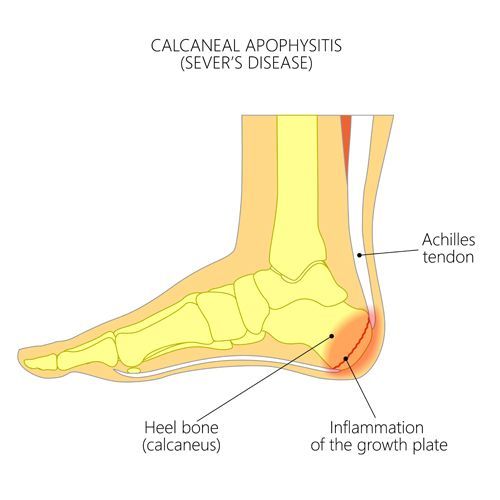Sever’s Disease Melbourne
What is Sever’s disease?
Sever’s disease, also known as calcaneal apophysitis, is a growing condition causing heel pain in children. It is caused by excessive muscle strain on the growth plate of the heel bone.
Sever’s disease is most common during children’s growth years around ages 8 – 14 and slightly more prevalent in boys than girls. Symptoms are generally worse after sport or activity, especially sports that involve a lot of running or jumping.
Does your suffer from Sever’s disease?
Signs & symptoms of Sever’s disease (calcaneal apophysitis)
The following signs or symptoms may indicate Sever’s disease in a child:
- Pain or swelling in one or both heels
- Pain is usually worse after sport or activity but can also occur during the activity
- Symptoms are usually worse with running and jumping activities
- Pain may cause the child to limp or avoid placing pressure on the heel
- Pain is better with rest

Causes of Sever’s disease
Sever’s disease is caused by excessive strain on the growth plate of the heel bone by the achilles tendon, which is the tendon that attaches the calf muscle to the heel bone. This leads to pain and swelling in the growth plate of the heel (calcaneus).
Growth plates are soft areas of cartilage where new bone grows from. Excess traction on these areas by tendons cause swelling and pain within the soft bone. Sever’s disease will resolve once the growth plate of the heel closes or stops growing. The soft bone is turned into hard bone and less prone to traction.
Not all children will get Sever’s disease but those that have tight calf muscles and poor foot function are often more prone as these factors increase strain on the growth plate.
Poor foot function or flat feet causes a child’s foot to pronate excessively or roll in. This causes bowing and excess strain on the achilles tendon. Excess pronation will result in more traction by the achilles at its insertion in the growth plate of the heel, potentially leading to Sever’s pain.
Sever’s disease diagnosis
Sever’s disease is easily diagnosed clinically by our Melbourne children’s podiatrists, who are experts in children’s foot problems. Referral for x-rays are not required.
A children’s podiatrist is the best health professional at diagnosing Sever’s disease so don’t delay in seeking assessment with one of our friendly team if your child suffers from foot or heel pain.
Podiatry treatment for Sever’s disease
The children’s podiatrists at Melbourne Podiatrists & Orthotics are experts in the treatment of children’s foot problems including Sever’s disease. Treatment is aimed at limiting and managing symptoms until the child grows out of the condition, so the child can continue their daily activities and participate in sport with minimum pain.
Treatment options at our Melbourne podiatry clinic include:
- Children’s orthotics
- Footwear advice
- Strengthening and stretching
Children’s orthotics work by supporting the foots natural arch, whilst improving foot function and alignment. This helps to improve and straighten the line of pull of the achilles tendon, reducing strain on the muscle. This results in less traction on the growth plate and a reduction in heel pain symptoms for the child.
Sever’s disease symptoms can last anywhere between 6 months and 2 years and can greatly affect a child’s daily activities as well as participation in sport, so don’t delay in seeking podiatry treatment if your child suffers from heel pain.
A children’s podiatrist is the best health professional to diagnose and treat Sever’s disease.

Does your child suffer from Sever’s disease?
At our Melbourne foot clinic our children’s podiatrists are experts in the diagnosis and treatment of children’s conditions affecting the foot, ankle and lower leg. This includes Sever’s disease or calcaneal apophysitis.
So if your child is complaining of a painful heel or limping book an appointment with one of our friendly children’s podiatrists today!


